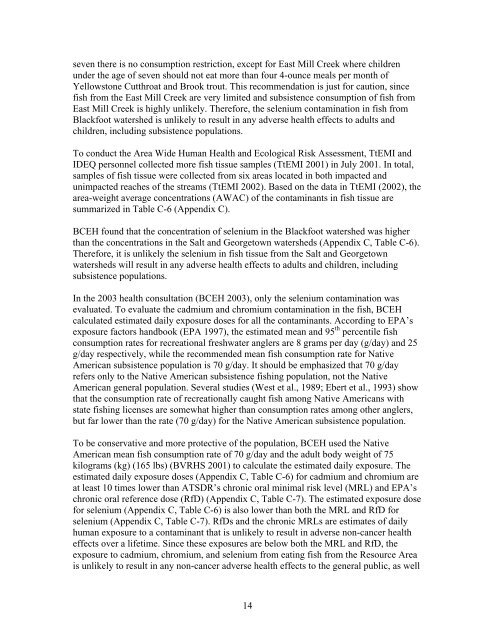Southeast Idaho Phosphate Mining Resource Area - Agency for ...
Southeast Idaho Phosphate Mining Resource Area - Agency for ...
Southeast Idaho Phosphate Mining Resource Area - Agency for ...
Create successful ePaper yourself
Turn your PDF publications into a flip-book with our unique Google optimized e-Paper software.
seven there is no consumption restriction, except <strong>for</strong> East Mill Creek where children<br />
under the age of seven should not eat more than four 4-ounce meals per month of<br />
Yellowstone Cutthroat and Brook trout. This recommendation is just <strong>for</strong> caution, since<br />
fish from the East Mill Creek are very limited and subsistence consumption of fish from<br />
East Mill Creek is highly unlikely. There<strong>for</strong>e, the selenium contamination in fish from<br />
Blackfoot watershed is unlikely to result in any adverse health effects to adults and<br />
children, including subsistence populations.<br />
To conduct the <strong>Area</strong> Wide Human Health and Ecological Risk Assessment, TtEMI and<br />
IDEQ personnel collected more fish tissue samples (TtEMI 2001) in July 2001. In total,<br />
samples of fish tissue were collected from six areas located in both impacted and<br />
unimpacted reaches of the streams (TtEMI 2002). Based on the data in TtEMI (2002), the<br />
area-weight average concentrations (AWAC) of the contaminants in fish tissue are<br />
summarized in Table C-6 (Appendix C).<br />
BCEH found that the concentration of selenium in the Blackfoot watershed was higher<br />
than the concentrations in the Salt and Georgetown watersheds (Appendix C, Table C-6).<br />
There<strong>for</strong>e, it is unlikely the selenium in fish tissue from the Salt and Georgetown<br />
watersheds will result in any adverse health effects to adults and children, including<br />
subsistence populations.<br />
In the 2003 health consultation (BCEH 2003), only the selenium contamination was<br />
evaluated. To evaluate the cadmium and chromium contamination in the fish, BCEH<br />
calculated estimated daily exposure doses <strong>for</strong> all the contaminants. According to EPA’s<br />
exposure factors handbook (EPA 1997), the estimated mean and 95 th percentile fish<br />
consumption rates <strong>for</strong> recreational freshwater anglers are 8 grams per day (g/day) and 25<br />
g/day respectively, while the recommended mean fish consumption rate <strong>for</strong> Native<br />
American subsistence population is 70 g/day. It should be emphasized that 70 g/day<br />
refers only to the Native American subsistence fishing population, not the Native<br />
American general population. Several studies (West et al., 1989; Ebert et al., 1993) show<br />
that the consumption rate of recreationally caught fish among Native Americans with<br />
state fishing licenses are somewhat higher than consumption rates among other anglers,<br />
but far lower than the rate (70 g/day) <strong>for</strong> the Native American subsistence population.<br />
To be conservative and more protective of the population, BCEH used the Native<br />
American mean fish consumption rate of 70 g/day and the adult body weight of 75<br />
kilograms (kg) (165 lbs) (BVRHS 2001) to calculate the estimated daily exposure. The<br />
estimated daily exposure doses (Appendix C, Table C-6) <strong>for</strong> cadmium and chromium are<br />
at least 10 times lower than ATSDR’s chronic oral minimal risk level (MRL) and EPA’s<br />
chronic oral reference dose (RfD) (Appendix C, Table C-7). The estimated exposure dose<br />
<strong>for</strong> selenium (Appendix C, Table C-6) is also lower than both the MRL and RfD <strong>for</strong><br />
selenium (Appendix C, Table C-7). RfDs and the chronic MRLs are estimates of daily<br />
human exposure to a contaminant that is unlikely to result in adverse non-cancer health<br />
effects over a lifetime. Since these exposures are below both the MRL and RfD, the<br />
exposure to cadmium, chromium, and selenium from eating fish from the <strong>Resource</strong> <strong>Area</strong><br />
is unlikely to result in any non-cancer adverse health effects to the general public, as well<br />
14
















